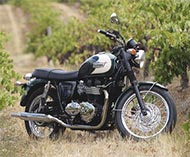
Edward Turner was a dab hand in motorcycle design,
numbering the Ariel Square Four and the Triumph Speed Twin (later to grow into
the Bonneville) among his, um, triumphs. But did you know he was had a knack of
coining smart names, too?
It was Turner who came up with the name
Thunderbird for one of the Triumphs he created. When Ford wanted to use the
name for a car, it had to ask permission. And when he decided Triumph would
commemorate breaking the motorcycle speed record on the famous
flats, he created a legend.
Rushed into production in 1959, the T120
Bonneville was not much more than a Tiger 110 with a higher compression ratio,
twin carburettors and no air filter. It had touring handlebars and, in its
original version, an odd headlight nacelle of the type later found in Iron
Curtain motorcycles. It was also an absolute ripper, partly because Turner did
not overreach himself.
“The Bonnie was the pinnacle of the original
Edward Turner design,” writes Roy Bacon in his dry but authoritative book Triumph Twins & Triples, “being no
larger than he thought was reasonable for a 360-degree parallel twin with no
special counterbalancing … in his view 650cc and 6500rpm are about the limit
before vibration and wear become problems and spoil the machine for the rider.
He also kept his machines light and easy to
handle so they were pleasant to ride and of simple construction so they were
easy to maintain all over the world.”
The engine was even oil-tight, although lubricant
did sometimes seep out of the oil filler cap.
Roll forward to the end of the old Triumph. The old
factory land at
John Bloor’s resurrected the brand at
With a feeling for nuances that almost rivalled Turner’s, Bloor happily adopted
some of the old brand’s names for his new bikes – such as Trophy – but left the
two most powerful ones alone.
Thunderbird was to see life again briefly on an
across-the-frame triple, but Bonneville had to wait until he had a bike that
could reasonably be described as a modern incarnation of the original machine.
That moment arrived with the first of Triumph’s new “classic” twins, and the
Bonneville was reborn.
This year, the Bonneville – or at least the name
– turns 50. Today’s Bonnie is powered by a considerably larger engine than
Turner would have thought advisable, but technology has moved on. It’s now
powered by a fuel-injected but still air-cooled, 865cc parallel twin that’s
intended to deliver the unique Triumph sound and feeling just as the original
did.
But the new Bonneville, reborn icon of the 1960s
that it is, is not standing still. A couple of quite minor but significant
changes have brought the bike forward a decade. It’s really not much – little
more than alloy wheels (smaller at the front at 17 inches) instead of spoked
ones, reverse-cone exhausts, shorter mudguards and a slimmer seat – but it does
set the Bonneville and its new offshoot, the Bonneville SE, apart from the
existing top-of-the-line T100.
The plain Bonneville gets those changes, which
also produce a lower 751mm seat, loses its metal tank badge and comes only in
either black or white. Its new sibling, the Bonneville SE, adds a proper metal
tank badge, the twin instruments previously available only on the T100 and
two-tone paint options. The bikes cost $12,490 and $13,490 respectively, plus
on-road costs.
The T100 is essentially unchanged with a higher
seat and spoked (19 and 17-inch) wheels plus tank pads. It costs $13,990 plus
on-road.
Having ridden all three recently, I have to admit
that the difference between the new and the old configuration is very
noticeable. I wouldn’t have thought a smaller front wheel and a slightly lower
seat would have made such an impact, but they have.
The bad news first – for someone like me, no
giant at about 180cm, the Bonnevilles now feel a bit low. The T100 continues to
feel just fine. The T100 also feels a little more stable on really poor road
surfaces and would be my pick if I was doing a lot of gravel road riding. And
those cast wheels on the other bikes look a little too much as if they’re left
over from old Yamaha SR500 stock.
The Bonnies with smaller front wheels, however,
steer much more quickly than the T100 and feel significantly more nimble. In a
way you could say that their handling has caught up with their light weight.
They are, to not put it too technically, simply a lot of fun to ride.
That said, it’s difficult to come down on one
side or the other because there are things I like from both – and unfortunately
they are mutually exclusive.
I like the stability of the T100 on gravel and
the ’60s look imparted by the spoked wheels. I also find the seat more comfortable.
But I also like the joyful nimbleness of the Bonnevilles. But there may be a
way of deciding. Which model is the best value?
The two extremes shape up better than the SE in
the middle. I just don’t think a tank badge, a tacho and two-tone paint are worth
an extra grand, so the plain Bonneville wins that comparison. Yet I think the
spoked wheels, knee pads, traditional peashooter exhaust pipes and added
stability of the T100 are worth more than $500. So for my money it’s the T100. I
think Edward Turner would agree with me.
But I also suspect that I will be in a minority
as buyers discover just how much fun the alloy wheeled bikes can be.
